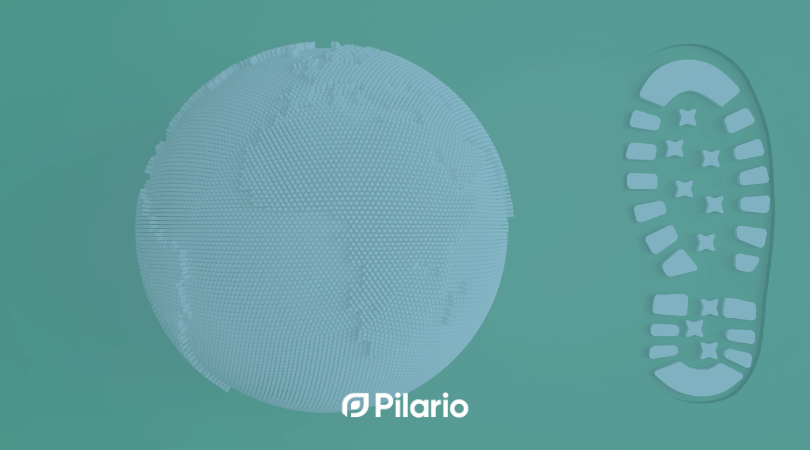07/03/2024
The Ultimate Guide to Understanding Product Environmental Footprint (PEF) in the EU
Unlock the EU's Product Environmental Footprint secrets: Drive sustainable choices and green innovation.

8 March 2024
Sustainability has become a central theme in global discussions as businesses, governments, and consumers increasingly recognize the urgent need to reduce environmental footprint. This growing awareness has led to the demand for standardized approaches to assess and communicate the environmental performance of products. Among these methods, the Product Environmental Footprint (PEF) stands out as a comprehensive framework for quantifying the environmental impacts of products.
The Product Environmental Footprint Category Rules (PEFCR) further refine this concept, providing detailed guidelines for specific product categories. These rules aim to standardize the way products’ environmental footprints are calculated. Which makes the comparison of the environmental performance of products more straightforward and trustworthy. Delve into what the PEFCR is all about in our comprehensive article.
Table of Contents:
1. Quick Insights Into Product Environmental Footprint (PEF)
2. Understanding The Product Environmental Footprint Category Rules (PEFCR)
3. The Development Process of PEFCRs
4. The Impact of Adopting PEFCR: Benefits and Obstacles
5. Global Impacts and Future Direction
6. Concluding Remarks: Towards a Sustainable Future
First, let’s quickly introduce the Product Environmental Footprint (PEF). This is a comprehensive metric initiated by the European Commission to standardize the environmental assessment of products across the EU. Central to this approach is the life cycle assessment (LCA), evaluating products’ environmental impacts of each step of their lifecycle.
The standardization of metrics, including greenhouse gas emissions and resource consumption within the PEF framework, strives to enhance transparency and comparability. This effort aids consumers in making knowledgeable choices while driving producers towards sustainable innovation. For a deeper understanding, we invite you to explore our comprehensive guide on the Product Environmental Footprint. Now, let us delve deeper into PEFCRs.
The Product Environmental Footprint Category Rules (PEFCR) represents a specification of the broader PEF methodology, on how to conduct a PEF study for a product of a certain category. By doing so, PEFCR makes it easier to measure and compare the environmental impacts of similar products accurately. This uniform approach benefits manufacturers, consumers, and policymakers by supporting sustainable, informed and data-driven decisions.
Acting as a comprehensive guide, PEFCR lays down exact parameters and methodologies for environmental assessments tailored to specific product types. It sets out clear parameters, methods, and criteria for impact assessments, ensuring consistent and comparable results. This consistency removes uncertainty and subjectivity from evaluations, leading to a transparent market where environmental performance is clearly compared, within a specific product category.
Furthermore, PEFCR is aligned with the main objective of the PEF to minimize environmental footprints. By offering detailed, category-specific instructions, PEFCR assists in pinpointing key environmental impacts. This helps companies enhance their eco-efficiency and supports policymakers in creating focused environmental rules. It also empowers consumers to choose greener options.
The creation of the Product Environmental Footprint Category Rules (PEFCR) is a detailed and collaborative process underpinned by the Product Environmental Footprint (PEF) framework. The journey starts with the formation of the technical secretariat responsible for guiding the PEFCR development process. The secretariat role is to coordinate activities, manage stakeholder engagement, and ensure that the methodology aligns with PEF standards.
The foundation of the PEFCR is built on an environmental footprint study of a Representative Product (RP) that reflects average sales in its category within Europe. This initial analysis provides essential insights into common environmental impact, serving as a benchmark.
The draft PEFCR, shaped by this study, incorporates stakeholder feedback from a widespread public consultation, ensuring diverse input shapes the framework. Additionally, manufacturers are invited to validate the draft PEFCR’s applicability through various practical studies, enhancing the document’s relevance and feasibility.
Following the initial evaluations, a second representative product (RP) study is conducted, reflecting the gathered input. This second study refines the benchmark and aids in updating the PEFCR draft, ensuring it accurately captures the environmental performance indicators relevant to the product category.
The process then moves to another phase of public consultation, combined with an evaluation by an independent third-party panel. This critical review phase is pivotal for incorporating diverse perspectives and ensuring the rules are both comprehensive and transparent. Following this review, the PEFCR undergoes final adjustments based on the insights and critiques received.
Once the PEFCR has been carefully examined and improved, it is submitted to the European Commission for final review and approval.This culminating step marks the end of an intense development process, resulting in a set of category rules that are scientifically grounded, industry-applicable, and environmentally impactful.
In essence, the PEFCR development process is marked by systematic steps, broad stakeholder involvement, and a commitment to transparency and scientific integrity. This structured approach ensures that the resulting rules not only meet the diverse needs and expectations of stakeholders but also align with overarching environmental sustainability goals.
The adoption of Product Environmental Footprint Category Rules (PEFCR) brings significant benefits to various stakeholders, including businesses and consumers.
For enterprises, PEFCR acts as a definitive guide, improving the calculation and communication of environmental performance. This uniformity helps reduce confusion and enables businesses to benchmark their products against industry standards, thereby identifying opportunities for improvement and innovation.
For consumers, the PEFCR framework helps them make informed choices by providing clear information about the environmental impact of products. This makes it easier to compare products within the same category using a verified and reliable method.
Despite the benefits, the implementation of PEFCR faces various challenges. The main challenge lies in the complexity and the significant resources required for comprehensive environmental assessments. Small and medium-sized enterprises (SMEs), in particular, may struggle with the technical and financial aspects of compliance, potentially limiting their participation in sustainability efforts.Variations in environmental commitment and awareness among countries and regions pose a risk to uniform PEFCR uptake and could lead to market fragmentation.
To address these challenges, establishing support mechanisms and incentives for businesses, especially SMEs, are crucial. Facilitating access to relevant tools, information, and training can aid in the PEFCR adoption process. Moreover, promoting collaborative networks and the exchange of best practices among stakeholders can improve the overall comprehension and execution of PEFCR standards.
At the same time, engaging consumers through education and awareness campaigns is another strategy to enhance the impact of PEFCR. By increasing public awareness of product environmental footprints and the significance of PEFCR, consumers can become active players in driving demand for sustainable products.
In summary, while the adoption of PEFCR offers considerable benefits in advancing product sustainability, it also presents challenges that require coordinated efforts to overcome. By addressing these obstacles, stakeholders can fully leverage the potential of PEFCR to foster a more sustainable and transparent market.
The worldwide adoption of Product Environmental Footprint Category Rules (PEFCR) promises to significantly steer global sustainability efforts. By standardizing the evaluation of product impacts, PEFCR sets the stage for a worldwide market shift towards more environmentally friendly products and practices. This initiative not only enhances the development and adoption of greener products but also encourages sustainable modifications throughout global supply chains, improving resource use, minimizing waste, and enhancing overall environmental conduct across sectors.
As PEFCR becomes more ingrained in global trade and regulatory landscapes, it has the potential to unify international environmental standards, easing trade barriers and fostering global ecological governance.
The evolution of PEFCR will likely be driven by advances in technology, regulatory evolution in the EU, and changing consumer behaviors. Innovations like blockchain and big data are set to revolutionize the transparency and verification of environmental footprints, enhancing the accuracy and trustworthiness of PEFCR assessments. Regulatory shifts may further propel the adoption of PEFCR, with more governments potentially mandating environmental disclosures or rewarding PEFCR-compliant businesses.
As consumer preference shifts increasingly towards sustainability, businesses will find more reasons to embrace PEFCR, integrating eco-conscious practices into their core strategies. This shift is anticipated to expedite sustainability’s role in business, reinforcing PEFCR’s global significance.
In conclusion, PEFCR marks a pivotal advancement in the pursuit of global product sustainability. Offering a detailed method for environmental impact assessment, it empowers companies to refine their practices and enables consumers to make informed, sustainable choices. Despite existing hurdles, the collective effort of all market participants can drive the successful adoption of PEFCR, leading to a greener, more transparent marketplace.
Every industry is closely monitoring the evolving landscape of PEF and PEFCR, anticipating their eventual mandatory status in a certain way. This shift has led to the development of Life Cycle Assessment (LCA) platforms and software designed to streamline compliance assessments for industry-specific products.
Pilario stands out as a comprehensive SaaS solution, enabling businesses to seamlessly integrate sustainability into their core strategies. With its array of predefined LCA models, tailored to meet specific PEFCR requirements for various sectors, including the PEFCR Beer and PEFCR detergents. With these ready-to-use LCA models, you can save time and money by performing life cycle assessments quickly and without the need for heavy investment in creating your own LCA model.
Looking forward, the persistent refinement and application of PEFCR will be essential in global sustainability initiatives, offering a pathway for stakeholders worldwide to partake in eco-friendly development. As the sustainability journey continues, PEFCR stands out as an essential instrument in the collective journey for a sustainable future.

07/03/2024
Unlock the EU's Product Environmental Footprint secrets: Drive sustainable choices and green innovation.

11/08/2023
Learn about the new French environmental labeling law for textiles.

26/01/2024
Uncover the difference between LCA and carbon footprint. Embark on a journey of sustainability with our expert guide!

22/09/2023
Unlock sustainable success with LCA, PEF, and PEFCR. Understand environmental impacts, gain trust, and comply with EU standards effortlessly.